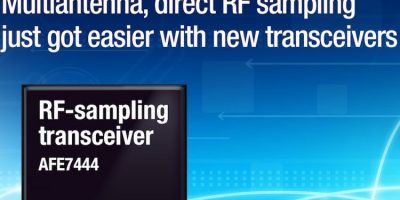Integrated quad- and dual-channel RF-sampling transceivers enable multiantenna wideband systems
Two RF-sampling transceivers that are said by Texas Instruments (TI) to be the first in the industry to integrate four analogue-to-digital converters (ADCs) and four digital-to-analogue converters (DACs) are targeting defence, and test and measurement applications.
The quad-channel AFE7444 and dual-channel AFE7422 transceivers help engineers achieve multiantenna, direct RF sampling for radar, software defined radio and wireless 5G applications.
Offering what is claimed to be the highest instantaneous bandwidth among radio frequency (RF)-sampling transceivers, the AFE7444 and AFE7422 enable engineers to achieve up to 600 per cent more data throughput.
While sampling up to 9 gigasamples per second (GSPS) per DAC and up to 3 GSPS per ADC, the AFE7444 receives and transmits up to 800 MHz of information from each of the four antennae, and the AFE7422 receives and transmits 1.2 GHz from each of the two antennae.
TI says the new RF-sampling wideband transceivers provide engineers with the flexibility to design applications covering any frequency from 10 MHz to 6 GHz.
The AFE7444 and AFE7422 enable engineers to support up to eight antennae and 16 RF bands with one device. Both allow engineers to directly sample input frequencies into C-band without the need for additional frequency conversion stages, eliminating local oscillators, mixers, amplifiers and filters in designs.
In addition, the two transceivers’ architecture allows for greater programmability than traditional RF solutions, and flexible decimation options enable optimisation of data bandwidth.
With four ADCs and four DACs in one chip, the AFE7444 and AFE7422 can also help engineers reduce design cycles that are associated with the manufacturing and testing phases required when designing with discrete components.
Measuring 17 mm x 17 mm, TI’s RF-sampling transceivers can help save engineers 75 per cent of board space when compared with using discrete RF-sampling data converters.
The integration and small size of the two transceivers enable engineers to optimise transceiver proximity to the antenna, enabling digital beam forming in high-frequency and high-density antenna arrays.




